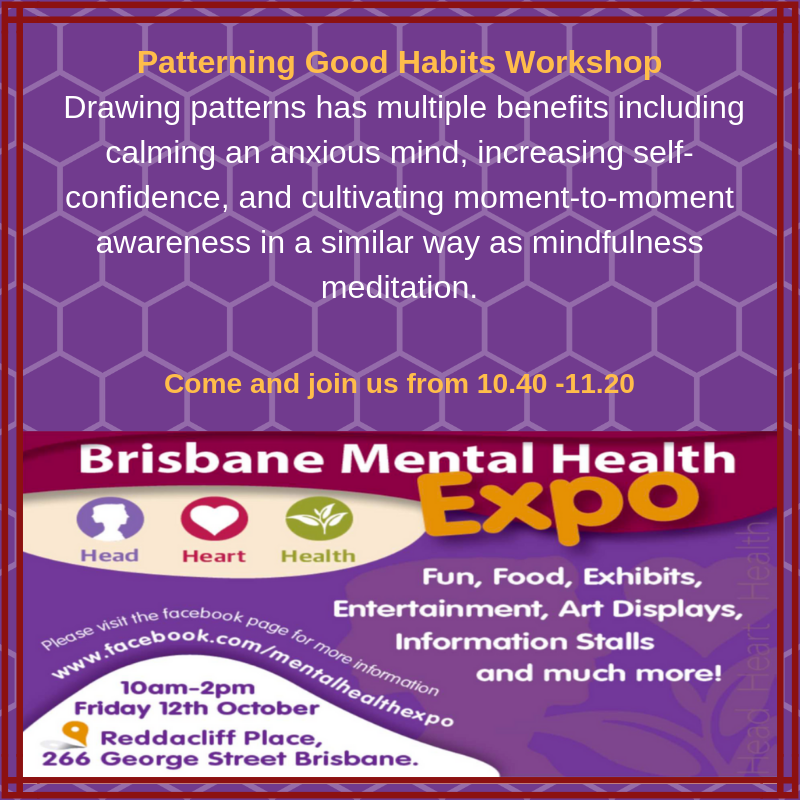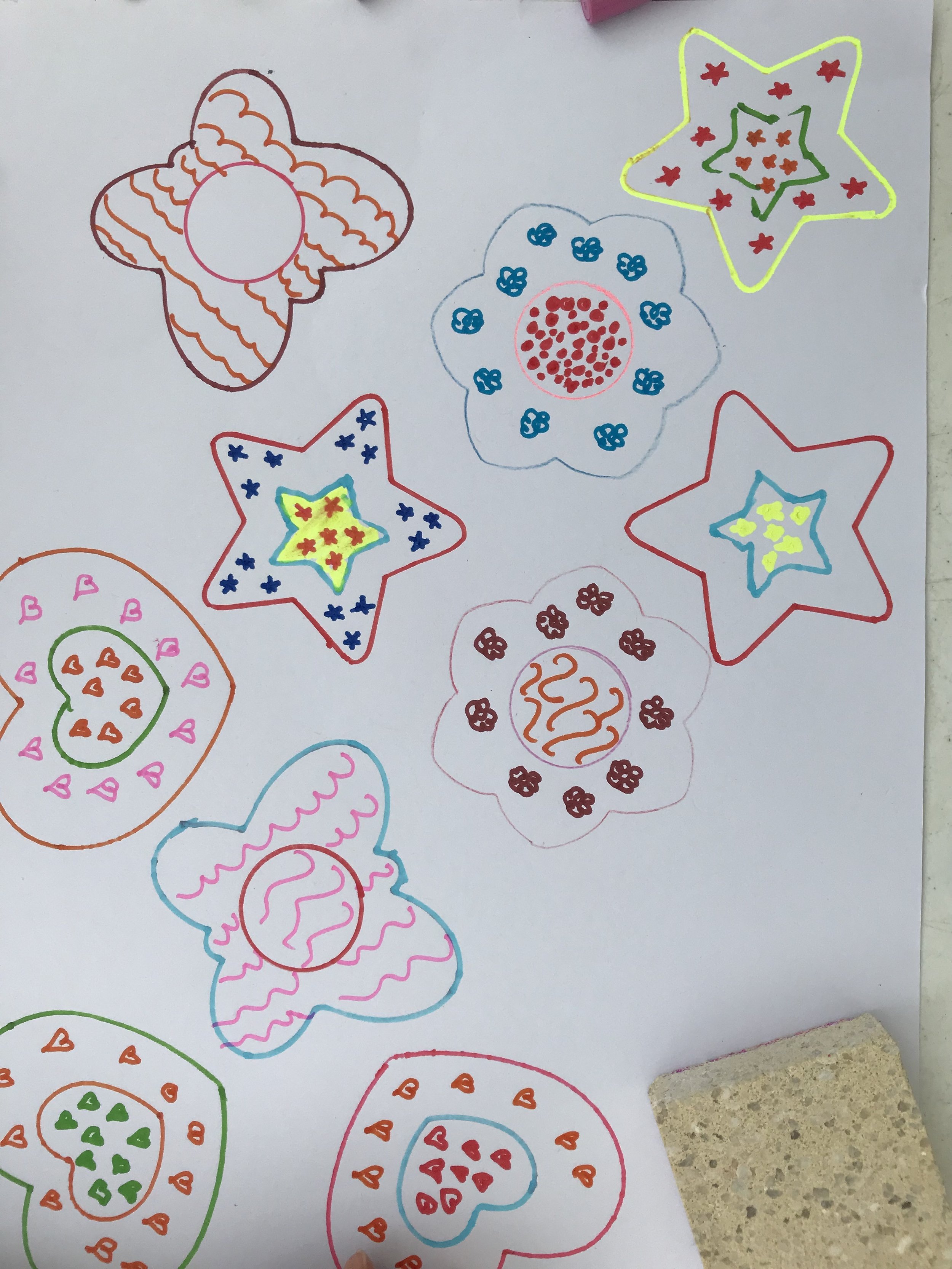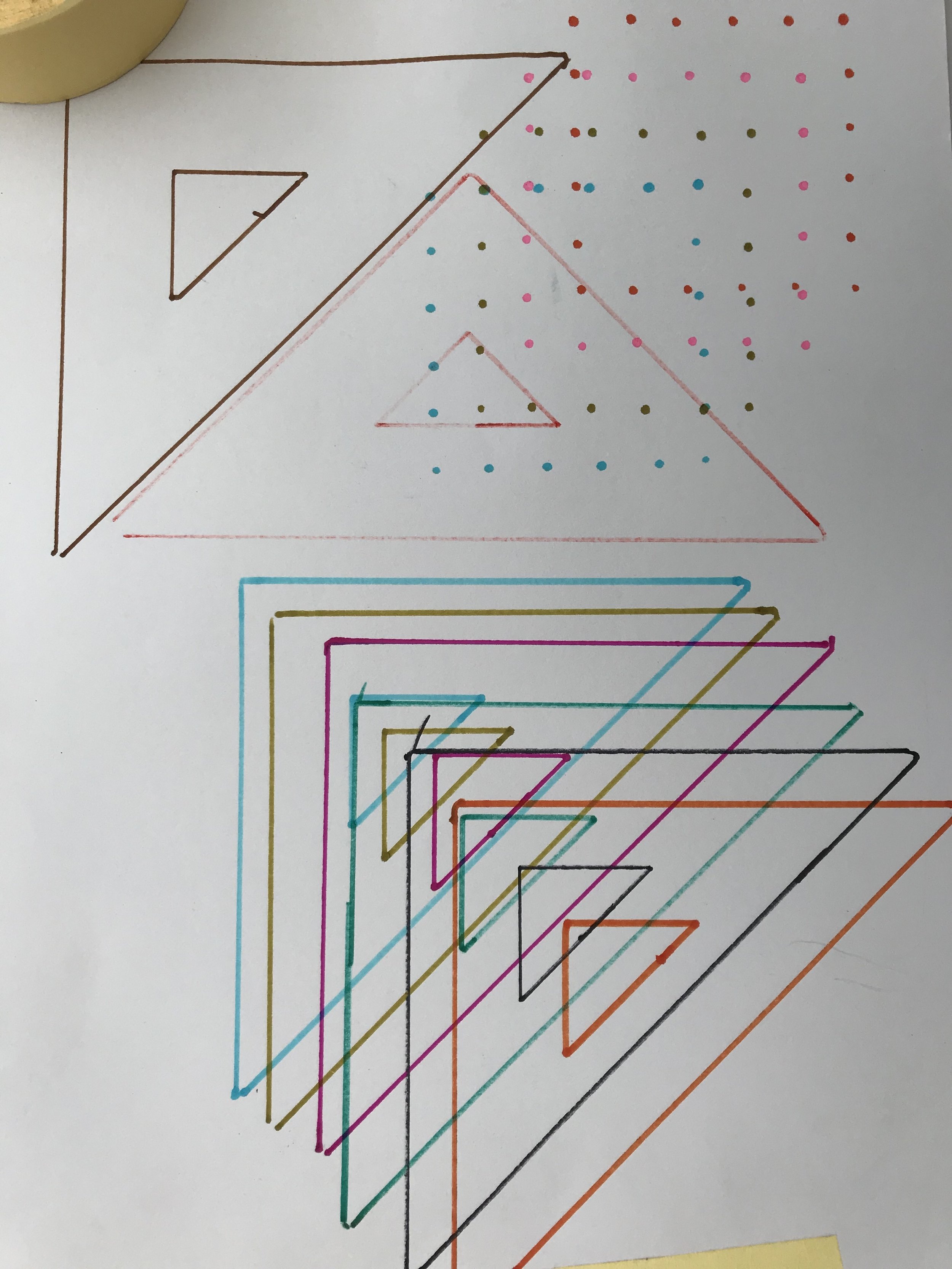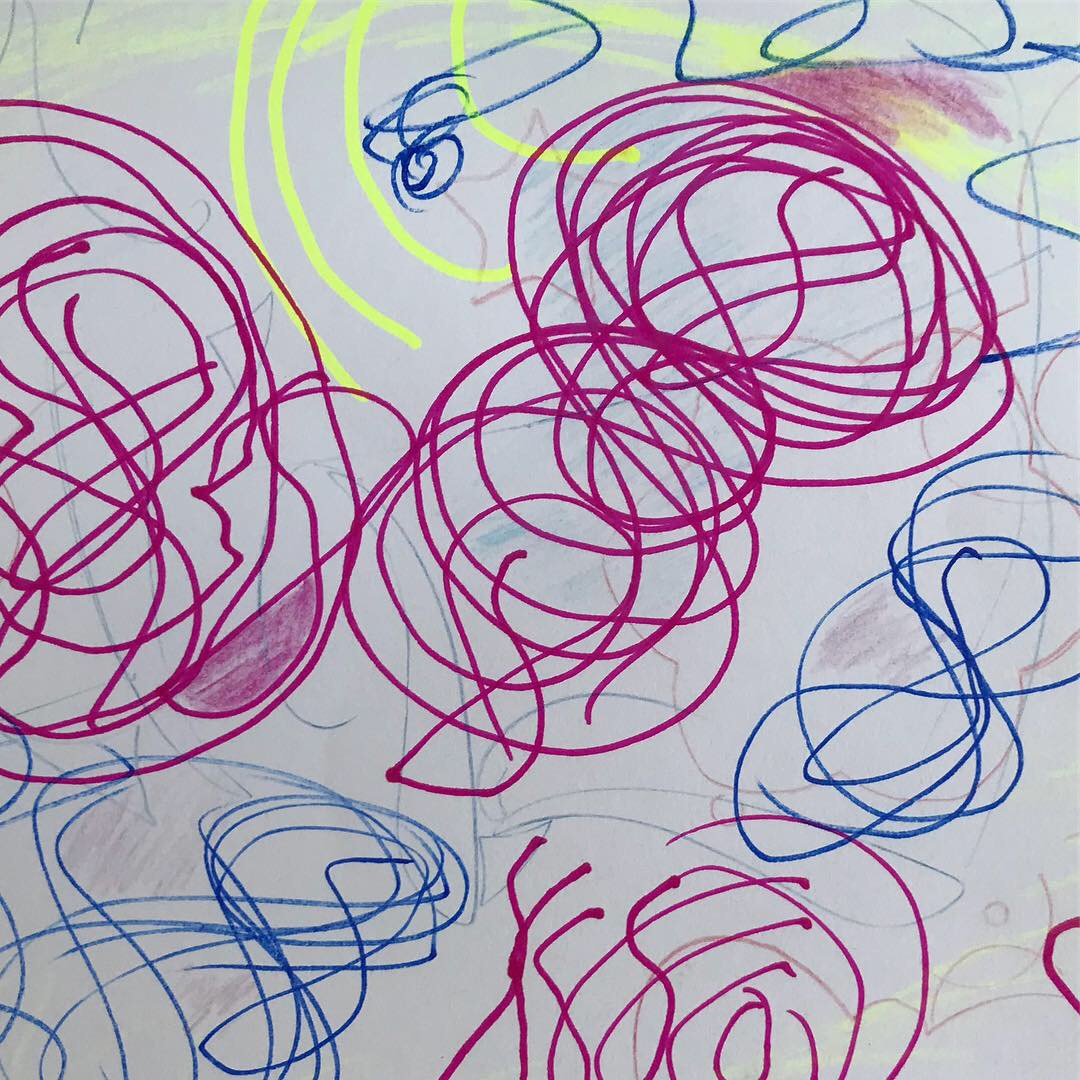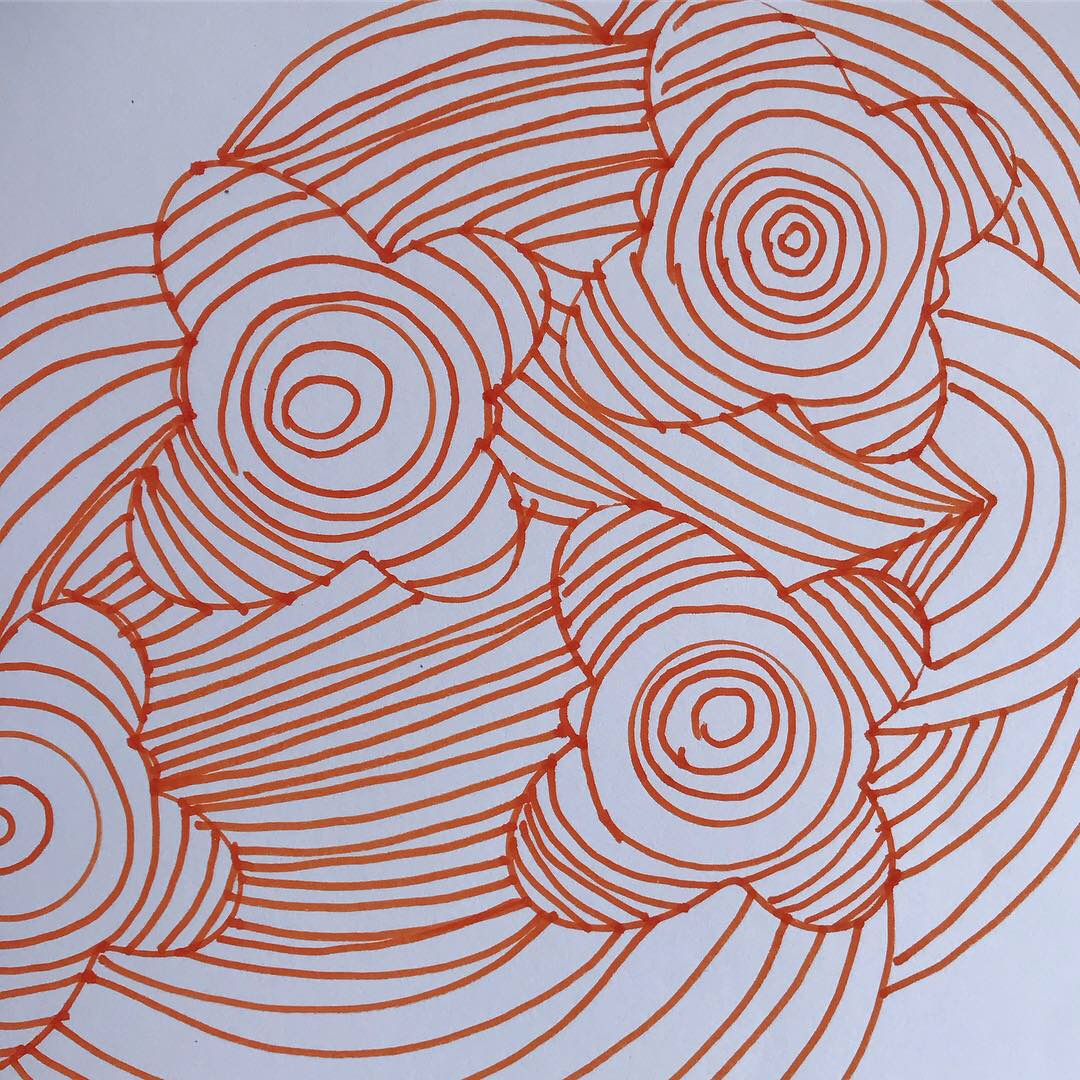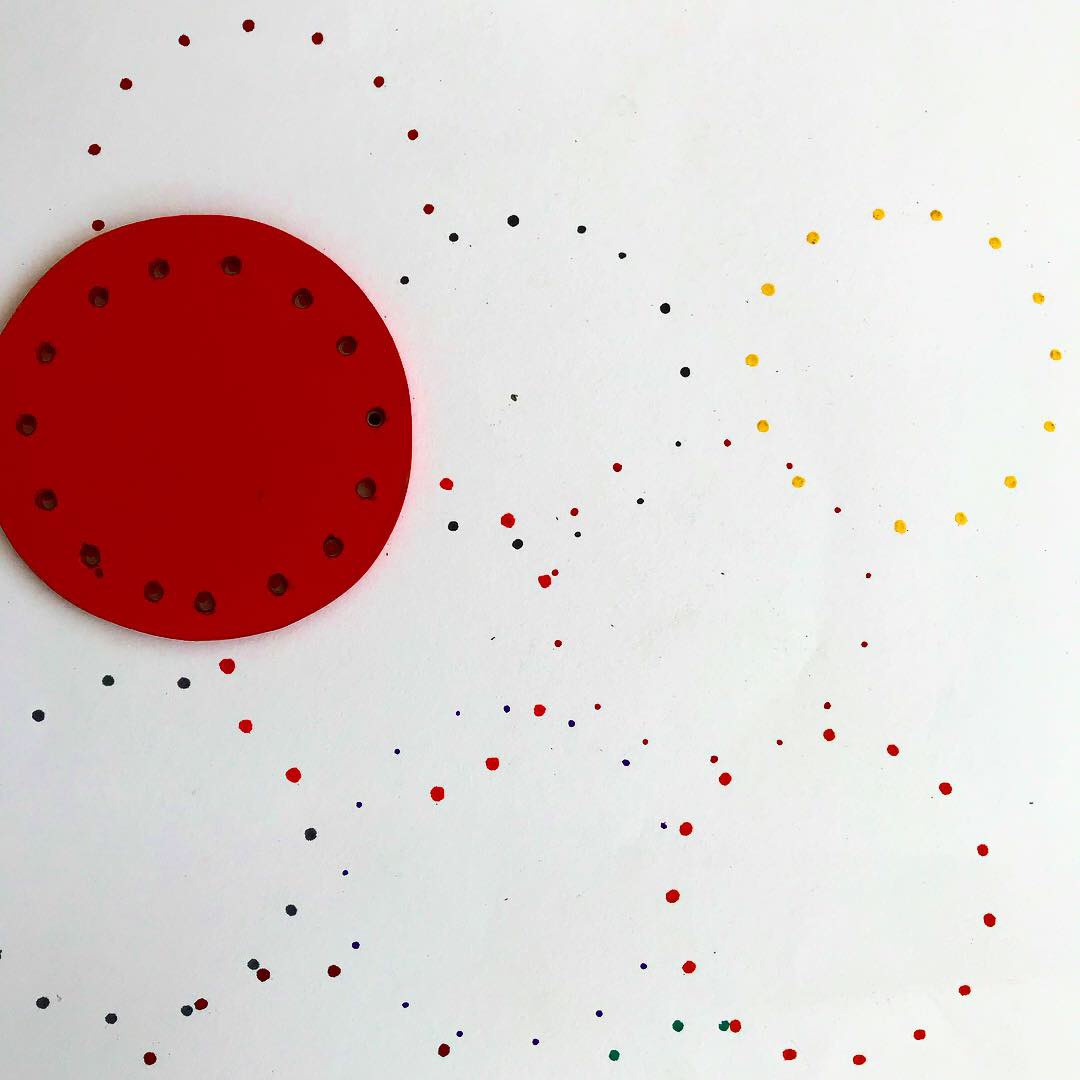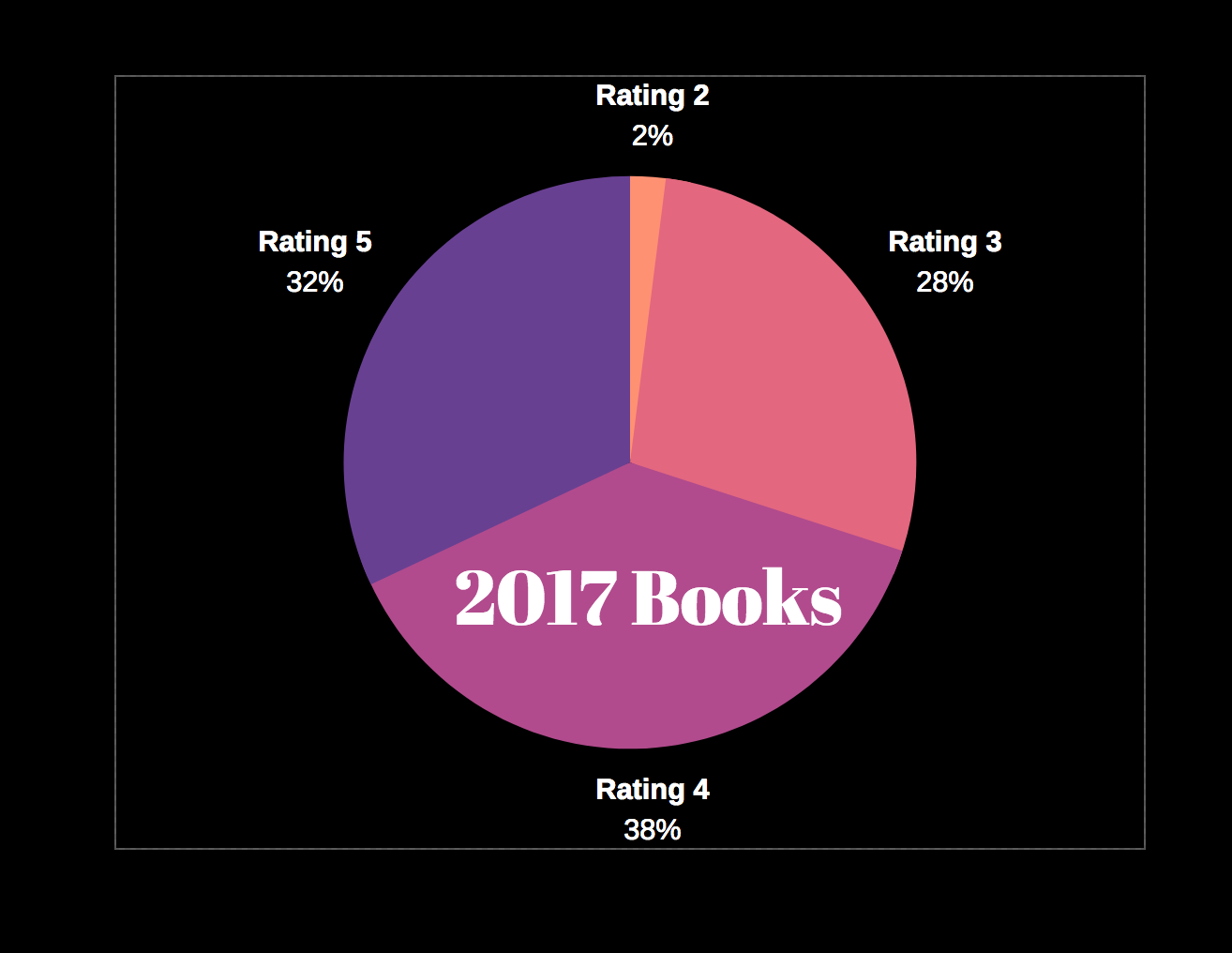I rediscovered art after the birth of my third child. I was in a slump - befuddled, listless, isolated and ill. Both Mum and a therapist suggested I do a course to meet people to help with the isolation. This lead me to the Brisbane Institute of Art where I enthusiastically attended painting courses for six years. The effects have been tremendously positive for my wellbeing and I have come to realise that the process is more valuable to me that the outcome. It has become a contemplative practice as outlined in my list of four.
Experimenting - There’s a fusion of colours, styles, materials and ideas to play with, the ever-present curiosity of “What happens if …”
Problem Solving - Making art means that you risk making mistakes; some misplaced marks cannot be erased. Art making teaches you how to incorporate what seem like “mistakes” into the overall pattern of the design. It’s a great metaphor for everyday life—nothing is ever perfect, but how you adjust to mistakes is what really matters.
Flow State - Creating often leads in to a state of flow, which Csíkszentmihályi describes as “an intrinsically rewarding or optimal state that results from intense engagement with daily activities”. It’s a simple way to enjoy the creative process.
Calming - Repetitive creative work, in and of itself, can be calming and self-soothing. This is particularly true if you accept this process as one with no expected outcome other than the enjoyment of making something and staying open to whatever emerges.
If you’re also an art maker, artist or art dabbler, I’d love to hear why you make art.
Limber Limbic
Our hyper-connectivity means we now consume more negative energy in a day than previous generations did in a lifetime. This overexposure often leads those who want for nothing wanting more - a permanent state of disenchantment. Our old limbic brain, maladjusted for modern society, reads this disenchantment as threat and responds with fight or flight or for me fright mode.
It’s common and perfectly natural when caught in the grips of fear to become controlling, emotionally unavailable and irritable, and to lose patience with ourselves and others. We want to feel safe so we cling to roles with their established rules and prescriptive behaviors. Frank Ostaseski - The Five Invitations
As we have become more secular we have lost the habit of gratitude. Saying grace before a meal gave us a moment to pause and reflect on our good fortune. Research concludes that building gratitude practices into your life leads to contentment. In place of bedtime prayers we could take a few moments to think about our day and give thanks. A friend of mine uses the acronym ILG - Infinite Love and Gratitude.
May you find ILG in this new decade.
Reattachment
This time between Christmas and New Year is for me a time of contemplation. My clever husband likes to call it the perineum, a diamond shape in the nether regions of our bodies. A diamond in the rough then, a rare gem of time slowing down, usual routines have vanished and I can spend time recovering, ruminating, reminiscing, revolting, resolving and maybe reattaching.
I’m halfway through and swept away by THE ATTACHMENT by Alisa Piper and Tony Doherty. It’s a pen pal relationship that nurtures my flagging spirit. Filled with thoughts, kindness, consideration, empathy, etymology, and friendship. A treasure, a gem, perhaps a diamond, in all ways perfect for the perineum of 2018.
Happy 2019!
Patterning Good Habits
The talented Maureen Hansen and I were delighted to be part of the Art Expo at the Brisbane Mental Health Expo on Friday. We met so many terrific people who spoke openly about their struggles with mental health and their strategies to maintain good mental health.
It was heartwarming to see that people responded well to making patterns and could feel more peaceful as they were participating. A few were very surprised to find they were more creative that they thought they were.
How it Works:
It’s Self-Soothing. Repetitive creative work, in and of itself, can be calming and self-soothing. This is particularly true if you accept this process as one with no expected outcome other than the enjoyment of putting the pen to paper and staying open to whatever emerges.
It Teaches How to Own Mistakes. Using a pen on paper requires that you risk making mistakes; in fact, most patterns some misplaced lines which cannot be erased. Patterning teaches you how to incorporate what seem like “mistakes” into the overall pattern of the design. It’s a great metaphor for everyday life—nothing is ever perfect, but how you adjust to mistakes is what really matters.
It Induces Flow State. This making of patterns often leads in to a state of flow, which Csíkszentmihályi describes as “an intrinsically rewarding or optimal state that results from intense engagement with daily activities”. It’s a simple way to enjoy the creative process.
Festival fascination
Byron Bay Writers Festival 2018
This was the first time I was fully immersed in a writers festival, I went the whole hog with a three day pass. On the eve of the festival we sat around perusing the program trying to map out the day ahead - six sessions to choose from at any point in the day. The festival pennants beckoned, brimming with excitement and armed with almonds I was eager to listen to writers talk about my most favourite pastime - reading.
At the end of the first day I was in a kind of rapture, impressed by everything: how the festival was organised, the friendly volunteers, the camaraderie of festival-goers, the laughter, the open-heartedness of writers. It was a peek into how society could be - a place that welcomed diversity, encouraged deep thinking, was non-judgemental and respectful. Instead of the pall of gloom I feel when watching or reading the news, I felt hopeful about the future and our capacity to be a kind nation. After looking through the notes I scrawled it seems to me the theme was HUMANITY.
Tracy Moffat told us that her work is about the human condition, “If I’ve had a breakdown while making the work it usually works, if I have fun making it, it doesn’t work”. She headed to New York seeking a wider audience and found a frenetic group of artists where everyone was busy working on a show. “An artist’s life is up and down, you just have to keep going.” Tracy advised artists to be vague about their work, she has avoided speaking about her work because it can stop different ways of reading it.
This resonated with Lloyd Jones assertion that explaining a book is the task of the reader, not the writer. His latest book The Cage was inspired by the indifference to Syrian refugees he witnessed in Europe. His indignation lit the fire to write this exploration of the difference between looking, watching and witnessing. He believes the world is divided by people who do and do not have a home and that we will do anything to those people without a home. “Art closes the gap to evoke emotion about an issue …The eye is not empathetic it just sees what it sees”, the responsibility of empathy lies with the reader, the narrator of the book is the witness who reports to the reader in a very bureaucratic way.
“Something has been torn down in the world and must be repaired”, was Sarah Sentilles reaction to the Abu Ghraib photographs of torture. For her book Draw your Weapons she describes using collage writing to craft “a song for the dead that never get grieved”. A collection of paragraphs to speak out against violence, it’s a process of taking what you’ve written chopping it up, arranging in themes and then retyping into your computer to commit to your words. Sarah has replaced Christianity with creativity and responsibility and told us that the most ethical thing you can say is “I might be wrong”. It did me a power of good to hear her describe herself as an earth-based feminist, activist, writer and theorist who is trying to make life better for the vulnerable.
In the second worst year of his life, Kon Karapanagiotidis was approached by Harper Collins who thought he might have a book in him. His memoir The Power of Hope is about compassion, hope and despair, but also the importance of being idealistic. Kon went into the caring profession as a way of caring for himself. He volunteered for every charity he felt a connection with, the first being homeless men - he has found humanity with all these outside, marginal groups. “Our vulnerability and fragility is what makes us beautiful”, when you’re attacked for being a bleeding heart, naive or idealistic, his advice is turn turn it back on the attacker by getting them to justify their indifference. He encourages us to gather our spirit and courage, to talk about values as a way of pushing back against the national stain of our refugee policy that weaponises people and fear.
Ellen Briggs and Mandy Nolan are women like us, mothers who get on with the busyness of family life and use it as fodder for their stand-up comedy. They’ve penned a book about these experiences which while hilarious also has chapters on the sadder, harder aspects of life. As Mandy explains it takes some work to rise from the “narcissistic pit of self-loathing”. They feel their comedy is not about having a solution but that the act of sharing experience is powerful. It’s when we can recognise those moments in our own lives and have the discernment to file the experience as absurd rather than tragic which makes for comedy. Humour is a release from the intensity of living.
On the subject of “How Fiction can Foster Empathy”, Matt Haig said that “reading is a telepathy a deep conversation through time - it comes alive in your own mind”. Elise Valmorbida added that reading allows us to sort through “the murkiness of morality” by imagining ourselves in the same situations as the characters in books. What would we do, would our moral compass stay true or would we protect those we love at any cost? Trent Dalton who read books to explore other ways of living found that this gave him the emotional intelligence to see good in almost everyone. In his writing his characters help us look at life through alternate lenses. This is true of all books, Matt Haig who has battled mental illness in his life is convinced that this has made him a more optimistic writer.
Josephine Wilson took this idea further, she is interested in the ethics of plot, concerned about the character stereotypes who are dispensable, killed off even to enable the main character to move on or realise something. She puts a lot of faith in the reader leaving us to sort out what’s authentic or inauthentic, by evoking yearning with the ending the reader wants to be hopeful but can’t be sure. Josephine uses objects to help tell the story, stirring up memory, which in turn can be so unstable because we want to rewrite the past and when we find out something new we may have to rewrite that history.
Ceridwen Dovey introduced us to the intriguing notion of a Bibliotherapy Service that prescribes books to make you feel better/happier. She was given a gift voucher for the service - after answering a questionnaire, she was prescribed transcendent fiction which helped her rehearse for real life. According to Ceridwen it doesn’t matter that we fail to exactly recall books and authors “we don’t store the content, what we keep is the memory of where you were and how you were feeling”. In this panel books that had affected the authors were recommended to the audience such as Ryszard Kapuscinski’s The Other - a collection of essays showing how it is possible to have full respect for others. By striving to understand the other reading becomes a political act of broadening and enriching our experience.
Finding where we belong joined authors Mark Brandi, Future D. Fidel and Lisa Walker who have written in the child’s voice discussing the appeal of this viewpoint that I have always found so readable. Their experience led to these thoughts on the subject:
The inscrutability of the adult world
How raw and emotional a child’s world can be
If you don’t have someone there for you, you can do the unthinkable
Secrets limit our decision-making
You belong where you are safe and accepted as you are
Home is wherever the loved ones are - you fight hard to find a place of belonging
Hearing Louise Milligan talk about excellence in journalism was heartbreaking. Her investigative pieces into abuses by the catholic church have relied on gaining the trust of sources, now a series of legal challenges are threatening to jail her for not revealing these sources. It was a sobering insight into the values of these dedicated professionals and difficulties put in their path to prevent publication. Such a contrast to the often shouty opinion pieces that have become a substitute for journalism. The motivation for Louise to continue is that she finds “something deeply moving about humanity”.
Sensationally impassioned Lemn Sissay was for me a new discovery. I came away from his session in a stupor of awe at his ability to to articulate his world view and to rouse a passionate response in those around him. A few of the quotes I wrote were:
“We’re so damn sanctimonious.”
“Dysfunction is at heart of all functioning families, which is why Christmas is so damned difficult."
“I dislike words that institutionalise people like Children in Care.”
“Bad things make good bridge builders.”
“I was growing wings all the time and I could fly.”
My final treat was listening to Melissa Lucashenko talk about her book Too Much Lip, written using the spirit of fight inspired by her grandmother. A humorous fictionalised follow-up to her Walkley Award winning piece Sinking Below Sight about single mothers in the “Black Belt” of South East Queensland. The book aims to lift the energy of the struggle. “Anger and depression is the current energy, I want to raise the optimism”. To finish my wrap/rapture of the Byron Bay Writers Festival 2018, a relatable quote from Too Much Lip:
“Too much lip, her old problem from way back. And the older she got the harder it seemed to swallow her opinions. The avalanche of bullshit in the world would drown her if she let it; the least she could do was raise her voice in anger. Give the arseholes a blast, then stand and defend, or else run like hell.”
Networks
Advancing Women in Business held a Parliamentary Reception on Tuesday night as part of a larger week of celebrations for International Women's Day.
We were ushered into a room stacked with portraits of Queensland pollies with the only female entrant being the Queen. Why didn't Anna Bligh make the cut or our current Premier. The guests were contrary to the portraits with just a few token men in the crowd.
The idea was to talk with other women business owners, enjoy some pleasant music and listen to some female leaders. I was delighted to meet Suzie Collins, whose organisation Rural Sky, tends to mental health in the Goondiwindi region. Before Aunty Carol Currie welcomed us to country, she and I had a chat about family, death, cancer, Beaudesert, Fingal, Fraser Island, Straddie and Jagera which is the name for the brown snake that is the Brisbane river. This wise elder cared deeply about community and the welfare of children - it was a pleasure to spend time with her. One of the last conversations I had got me thinking. This woman had wondered why women were reluctant to talk about being business owners in general conversation, her point was that men often spoke with ease about being a business owner. I'm comfortable talking about Mindsettle in networking situations yet in other situations only talk about business if prompted. Perhaps for me it's a resistance to being defined/judged by what you do or how or even if you earn money.
Shannon Fentiman (Minister for Employment and Small Business and Minister for Training and Skills Development) was our host with special guests Louise Broekman, Managing Director of the Advisory Board Centre, along with the founders of the Femeconomy, Jade and Alanna. These speakers inspired us with their thoughtful words and exhortations about the value of community and collaborations. The motto of the night was "you can't be what you cannot see".
Creative Collaborations
This book was a lucky find for me from the local library. For the last few years I've been thinking of myself as a creative collaborator so this title leapt from the shelves. It's full of interviews with a variety of art collectives from different parts of the world. Their responses about the prevailing models within the art world were thought-provoking.
"When other structures, such as patrons and museums, are not making stuff happen for artists, then they group together to make things happen for themselves. In many ways that is the definition of collaboration: making stuff happen together. It is about action rather than process." Jane Pollard
"The ideas of authorship and originality were born in a very specific moment, in 1400, with the invention of print... There's not such a thing as 'the author' in that everything we do is influenced by things we have seen, heard or read, or by people we've met. Sometimes you forget it, so you think these ideas come from you, but they don't." Eva & France Mattes
Some of these collaborations operate anonymously which has always been an attractive option to me - a way to freely write about society without being judges or labelled personally.
"Anonymity is liberating, the possibility of doing and saying things without them being permanently attached to your actual persona is something we should protect." Eva & Franco Mattes
There were dismissive comments regarding the genius artist concept.
"We can't believe that the heroic lone genius idea is still alive. It's a simplistic and boring idea that nonetheless endures... we don't want to believe in the heroic lone genius because it produces an ugly world made of ugly selves... Capitalism is fuelled by driving individuals against one another." ayr
Some of the groups featured used the Internet to produce interactive work.
"I do have a sense that despite all the cynical structures on the Internet, it could still be this idealistic, tentatively egalitarian space, and we should work towards that." Luke Turner
I was inspired to read about people who were the antithesis of the prevailing "me" culture that currently prevails in our society.
Winning words
2017 was a great year for reading (what year isn't). Just to up the nerd factor of recording and rating the books I consume, this year I went the whole hog and created a chart. Out of the forty-seven books I consumed fifteen got the top rating of five. If you think you might like the books I like you can check out the winning list.
A Manual for Cleaning Women by Lucia Berlin: Stupendously written short stories that illustrate the everyday struggles of alcoholism, family dysfunction, romance, sickness and death. Lucia had an amazing capacity to bring her characters to life.
Buddhada by Anne Donovan: A delightful story about a family's ordinary struggles and the different ways we choose to cope. Set in Glasgow, it is told from the three viewpoints of mother, father and daughter. Written to reflect the Glaswegian accent so it takes a bit of getting used to, but the effort is worthwhile and eventually it seems normal.
The Amazing Adventures of Kavalier & Clay by Michael Chabon: Brilliant characters, compelling back stories - set in the lead up to and during WWII, reminding us of the peril of Jewish life, of being an outsider, an other and how new countries should offer new opportunities to belong.
shtum by Jem Lester: Written as a first person account of a father's struggle with his non-speaking autistic son and his fight to give him the best possible life.
Maestra by L.S. Hilton: A titillating ripper I could rip through - I needed to know what Judith did next.
Fallout by Sara Paretsky: The 18th V.I. Warshawski novel is another terrific installation in the series. Paretsky does the crime genre so well, always interesting to meet her new characters and to discover which social issue is the backdrop for the story.
number 9 dream by David Mitchell: Weird coming of age story mostly set in Tokyo. It took me a few chapters to get my head around the style, but because the main character Eiji was so lively I was prepared to dig in. Parts of the narrative are fascinating looks into fantasy, the yakazu and being part of the Japanese military in WWII.
The Art Of Living by Thich Nhat Hanh: An antidote to the woes of modern living. Sensible lessons to live a peaceful life.
Colorless Tsukuru Tazaki and his Years of Pilgramage by Haruki Murakami: I raved about this in a blog post last year.
Eleanor Oliphant is Completley Fine by Gail Honeyman: Cleverly takes us into Eleanor's world, slowly revealing her fucked up childhood. We see her at a turning point and I read through the pages compulsively to see how her life would proceed.
The Keeper of Lost Things by Ruth Hogan: Completely charming novel about finding purpose and hope after loss and despair.
Taboo by Kim Scott:Gritty story illustrating the complex relationship between Aboriginal culture and white settlement. Tilly Coolman lives in the modern murky world created from this history of displacement.
Home Fire by Kamila Shamsie: This is a book of our times that looks at how disenfranchisement develops. Told from the point of view of three London siblings whose parents hail from Bangladesh.
Here's to going places!!
Happy New Year!
The annual life audit is in process. What are my plans for this year? How did I measure up last year? Last January these were my plans for 2017:
- Continue to develop Mindsettle - launched as a business in March, clients are subscribing.
- Promote Nature Art Connect - resigned from the Lines in the Sand team to focus on Mindsettle.
- Write regularly - only managed to write irregularly, more routine required.
- Exhibit a series of art - featured Mindsettle footage at St. Vincent's Private Hospital as part of their Outside In exhibition and at the International Arts and Health conference at the Art Gallery NSW.
And so to 2018:
- Grow Mindsettle client list and content offering
- Write regularly - blog weekly
- Exhibit art
Whilst continuing everything that makes up my regime for family and personal contentment. May you also find contentment in 2018.
“IN THE END… We only regret the chances we didn’t take, the relationships we were afraid to have,and the decisions we waited too long to make.” Lewis Carroll
Because you're worth it
I found out quite a few interesting facts at a forum on Arts and Culture hosted by the Brisbane Powerhouse and the Queensland Chamber for Arts and Culture (QCAC). After Uncle Bob Anderson welcomed us Kris Stewart who is the Artistic Director of the Powerhouse set the scene. Queensland art organisations receive 12.5% of federal funding, if this money was allocated according to Queensland's contribution to federal coffers the amount would be higher than 20%. This funding split has remained consistent under successive government of various political persuasions. Having been on the grants treadmill while volunteering at Lines in the Sand I now see why my associates thought it was naive of me to try for an Australian Council grant. There are so many arts organisations assiduously working on grant applications to various government bodies and philanthropic trusts. These can take months to collate and often result in rejection. It's an art in itself to interpret how to write a potentially successful submission. Generally speaking the Australian population recognises the value of arts and culture in creating a vibrant, thoughtful society. Sometimes though it is easier to think of other places as artistic centres, like Paris. Though according to Kris, Brisbane has a bigger population than Paris - this was very surprising to me, because Brisbane has always been cast as a big country town it's easy to forget the growth we've had.
We recently had a Japanese exchange student to stay which gave us the opportunity to treat Brisbane as a tourist destination. The two art institutes we visited were the Queensland Art Gallery and the Museum of Brisbane. Immediately impressive with their accompanying architecture the content of the exhibits never disappoints. The Member for Brisbane Trevor Jones talked about his commitment to the arts outlining the collaborative approach he's making with his fellow Queensland parliamentarians and other levels of government. Mitch Fifield Minister for Communication and the Arts outlined the current federal funding structure. He was interested to hear how Queensland art organisations would prioritise funding and what structure this could be. The consensus seemed to be to prioritise First Peoples, Youth and arts access for people with disability. One of my favourite suggestions came from Sally Pitkin (Opera Queensland) for a position of Chief Artist with similar gravitas to a Chief Scientist. Both politicians urged those present to band together so we could speak with one voice. This was reinforced by Katherine Hoepper who directed us to join the QCAC. It was brilliant to witness these passionate representatives of Queensland arts and culture sharing their stories of funding hardship, innovation and collaboration.



